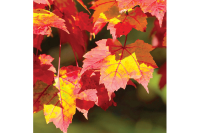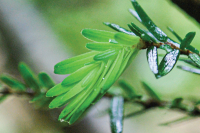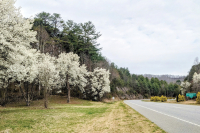The Naturalist's Corner: Eye on the lake
Lake Junaluska is an amazing resource. It is home to the Lake Junaluska Conference and Retreat Center, the World Methodist Council and Intentional Growth Center and attracts visitors and guests from all around the world. Area residents flock to the wonderful walking trail for a little exercise and/or to simply enjoy the beauty. It is becoming a regular haunt for photographers. And the new boat landing has provided more access for fishermen.
Evening gosbeaks to make rare appearance
“Seen for the first time amid the snows of winter and against a background of darkling pines these strange and beautiful waifs of the northland seem somehow out of place, as would some rare and singular exotic plant blossoming in ... winter.” — Dr. Elliot Coues, Birds of North America (1925)
Head up bird watchers! According to a recent news release posted online at eBird — an excellent source of information sponsored by the Cornell Lab of Ornithology — advised that early “observations are hinting at the largest movement of Evening Grosbeaks in the Northeast in more than a decade.”
The Naturalist's Corner: The skies are beginning to fill
Around 70 percent of the birds that nest in the Eastern U.S. are neotropical migrants — they nest here (U.S. and Canada) and overwinter in Mexico and/or Central and South America. There are around 200 species of neotropical migrants and many make extensive journeys. Shorebirds nesting in the arctic tundra and northern Canada have the longest migration. Species like red knots and white-rumped sandpipers may travel 10,000 miles between nesting and wintering grounds. Long distance migrants that nest in our area include red-eyed vireos, barn swallows, cerulean warblers, scarlet tanagers and more.
The Naturalist's Corner: It’s getting pinker
Our annual beach and marsh R&R at Wild Dunes on Isle of Palms, South Carolina, is history. Thanks to the generosity of dear friends we have been making the trip for a decade or so. It has become the high point of our summer and it never disappoints — but how could it, with wonderful beach and marsh access.
The Naturalist's Corner: Musings from count year 2018
This past spring was one of the more trying ones with regard to my annual U.S. Forest Service bird point survey. The survey runs each year from May 1 to June 15. You might have noticed it rained a bit in May. Of course, one can’t count in the rain, but according to protocol if it’s not raining counts may be conducted and this spring there were days I birded just after and just before rains. One thing I thought I noticed — on mornings with heavy cloud cover, especially those mornings where it had rained before dawn, birds were much quieter than normal.
The Naturalist's Corner: Lake J eagles
Most readers know the pair of bald eagles that nested at Lake Junaluska this spring were unsuccessful. There is no way to know the reason for nest failure. It could simply be this was a young inexperienced pair — once eagles attain adult plumage there is no visual clue to determine age. It could have been some kind of predator, but this seems unlikely because that would have created quite a ruckus and the eagles’ next-door, human neighbors would have probably noticed.
Learning bird songs is an art unto itself
Editor’s note: This column first appeared in a May 2009 issue of The Smoky Mountain News.
In the opaque early-morning light outside our bedroom windows, the birds that reside in our woods — or do we reside in their woods? — commence warming up for the day with tentative calls and whistles. The male cardinal seems to take the lead most mornings. Before long, however, the patterns arrange themselves into a tapestry of music.
The Naturalist's Corner: Back in the saddle
I have had, since 2004, one of the best gigs any bird nerd could ask for. That was when I was awarded my first U.S. Forest Service (FS) bird survey contract for three districts in the Pisgah National Forest. To say I didn’t know what I was getting into would be a great understatement. I was given some over-the-counter maps and a list of coordinates and was told all I had to do was find the points, mark them and then survey them.
The Naturalist's Corner: Not quite a wrap
The starting date for my annual bird survey for the U.S. Forest Service is May 1. All of our nesting species should be on territory by this date. Some, like Canada warblers, may not be here in great numbers but they will be represented in appropriate habitat.
The forlorn calls of the yellow-billed cuckoo
Editor’s note: This column first appeared in The Smoky Mountain News in May 2008.
O Cuckoo! Shall I call thee Bird,
Or but a wandering Voice?
— William Wordsworth









